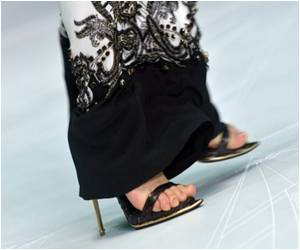
Yaodong Gu, Yan Zhang and Wenwen Shen of the Faculty of Sports Science, at Ningbo University, in Zhejiang, China, have shown that there are long-term risks for wearers of high-heels who find themselves regularly having to run.
The team measured the hip and ankle movements in young women running in different types of footwear - flat shoes heel (15 mm heel), low heel (45 mm) and high heels (70 mm).
They observed an increased motion of range of knee abduction-adduction and hip flexion-extension while the volunteers where running in high heels.
This, they explain, could induce high loading forces on knee joints. Moreover, they observed a decrease in ankle movement and inversion while running that correlated with heel height, which would be linked to a greater risk of sprain.
The researchers suggest that the higher the heel the greater the risk of an ankle sprain if running.
Advertisement
Source-ANI









